As the man from Independence might have said…
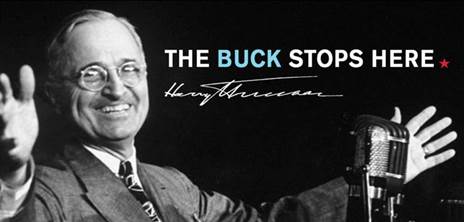
…IN COOPERSTOWN!
Ever since John Jordan “Buck” O’Neil charmed the country in Ken Burns’ Baseball series in 1994, Buck was destined for Cooperstown. When he was on the Hall of Fame ballot in 2006, most pundits assumed he would be elected. That did not work out, but last December when supporters gathered on the Field of Legends at the Negro Leagues Baseball Museum, we got the word that Buck had been voted in. Joy to the world! Below, celebrating with NLBM President Bob Kendrick.
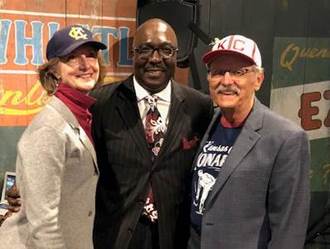
The joy from that December day carried over to July 24, 2022, when Buck O’Neil was formally inducted into the Baseball Hall of Fame. The induction speech for Buck was given by his niece Dr. Angela Terry, and it was to be paired with a video narrated by Bob Kendrick. But rainclouds were gathering in Cooperstown and the videos for all seven inductees were removed to shorten the program. The good news is that Bob’s video is online, so turn in your raincheck (by clicking here) and watch one great storyteller talk about another (4:24).
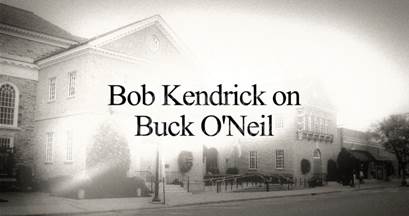
Thank$ a Million Buck!: And the celebration will continue. Five days after the induction ceremony, Bob Kendrick was back on the Field of Legends to announce a collective opportunity for fans to say “thank you” to Buck. Video here (4:50).

The campaign’s goal is to raise at least $1 million from fans donating a “buck” (or more) in support of the museum and the completion of the Buck O’Neil Education and Research Center at the site of the Paseo YMCA where the Negro Leagues were established in 1920. This is a nationwide campaign, and I’ve already seen a tweet by Ken Burns endorsing the effort. So please log on to ThanksAMillionBuck.com and give your buck (or more).
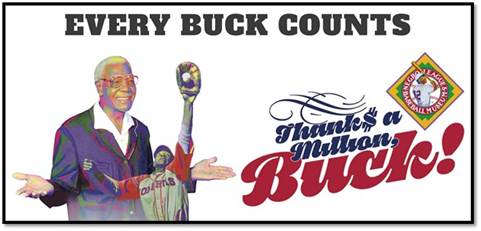
The Plaque: Channel 4 sports anchor Harold Kuntz was in the room at the Hall of Fame when Buck’s plaque was installed, and he posted this video (1:42).
The plaque will soon be temporarily removed so it can be brought to Kansas City and displayed on Friday, August 12, at the Negro Leagues Baseball Museum. The next day, it will be on display at Kauffman Stadium when the Royals take on the Dodgers in a “Salute to the Negro Leagues.” The Royals will be wearing 1945 Monarchs uniforms (the year Jackie Robinson played for the Monarchs) and the Dodgers will be wearing 1947 Brooklyn uniforms (the year Jackie broke the color line at Ebbets Field).
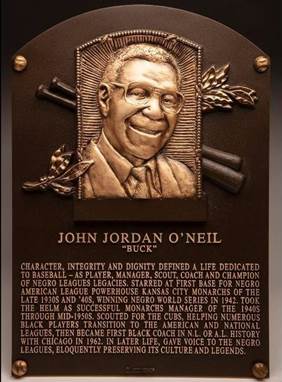
The Cooperstown Casebook: Seven players were inducted this year. Buck was in the “pioneer” category, as was Bud Fowler, the first Black in professional baseball. Fowler played in the 1880s before the “gentlemen’s agreement” segregated the game for over a half-century.
The other five entered the Hall as players voted in by the baseball writers (David Ortiz) and the Golden Era Committee (Minnie Minoso, Tony Oliva, Jim Kaat and Gil Hodges). A major purpose of the era committees is to elect players who should have been tapped by the writers, but missed out for some reason. The best source making the case for overlooked players is The Cooperstown Casebook by Jay Jaffe.
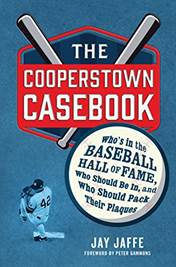
I consider Jaffe’s book to be the bible on Cooperstown eligibility, both on who should be in and those who he thinks “should pack their plaques.” The book came out in the summer of 2017 and has proved to be influential in Hall of Fame debates over the past five years. I bought the book when it came out and have a reminder in the front cover of when and where I read it:
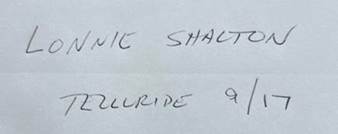
When Rita and I attend the Telluride Film Festival each fall, we go a few days early to get acclimated to the altitude. Great opportunity to read a couple of books while gazing at the mountains.
I reported on that 2017 festival in Hot Stove #52 and included this photo of Rita attending a filmmakers panel at an outdoor venue. The three filmmakers on stage, from left to right, are Lynn Novick, Ken Burns and Francis Ford Coppola. Novick and Burns were screening their PBS series on Vietnam. Coppola joined them to add flavor from his Vietnam movie experience with Apocalypse Now.
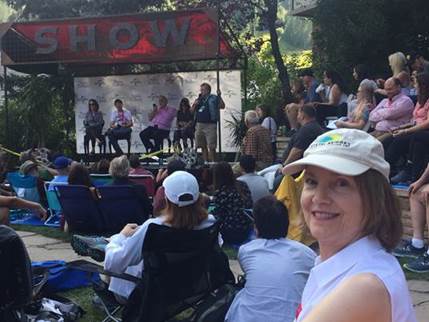
This circles back to Buck O’Neil because Burns and Novick were the co-producers of Baseball, the 1994 PBS series that introduced Buck to the world. My question: Was Baseball screened at Telluride in 1994? Google helped me find the answer.
Buck O’Neil, Ken Burns and Lynn Novick – Telluride and Beyond: It is not unusual to see Ken Burns in Telluride. He is a long-time sponsor of the festival and has screened episodes of several of his acclaimed series before they began running on PBS. We have been going to the film festival since 2011 and have seen him walking the streets with his family and appearing in forums and at screenings. In 2019, Rita and I saw Burns at a “Conversation” at the Telluride courthouse (photo below) when he was previewing his Country Music series. Last year, his Muhammad Ali series was screened.
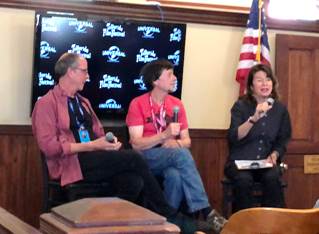
But how far back does Burns go at Telluride? Way back. In 1985, the festival screened his documentary on Huey Long. He started going to the festival every year, whether he had a film or not. It’s easy to become addicted. The mix of mountains and films is intoxicating.
In 1990, an episode of Burns’ The Civil War was screened at Telluride, and the full series went on to became a major hit on PBS. A fortuitous new-hire working on The Civil War was Lynn Novick, and her next assignment in the Burns’ portfolio was Baseball.
As part of her work as co-producer, Novick was tasked with weaving in the role of the Negro Leagues in baseball history. This was not an easy assignment. Baseball in general has a rich written history – books, newspapers, magazines – plus newsreels and other videos. But very little about the Negro Leagues. One of Novick’s sources was KC-based Negro Leagues historian Larry Lester who provided archival information and also gave her a good tip – talk to Buck O’Neil. Novick visited Buck at his home in Kansas City, and as they say, the rest is history. Buck became the heart and soul of the nine-part 18-hour PBS series.
Lynn Novick: “Buck just lit up the screen – he lit up the room, he lit up the world – with his spirit and generosity and just humanity.”
Buck also became part of the promotional tour for the series. The plan was to hit every major league city, and on August 3, 1994, the tour stopped in Kansas City where Burns threw out the first pitch at a Royals game. The catcher for that pitch was Buck O’Neil. They wore the Monarchs uniforms that the Royals were wearing that night to honor the Negro Leagues.
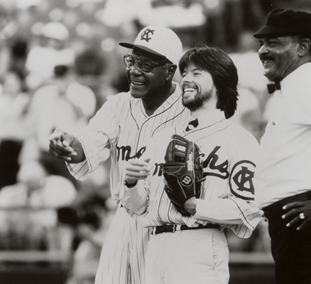
Nine days after Burns threw that first pitch, MLB players went on strike. The publicity tour to all the stadiums would not be completed. Talk about bad timing. The strike did not end until April of 1995.
But the show must go on. Over Labor Day Weekend in 1994, Baseball was screened at Telluride. Each year at the festival, two or three tributes are given to feature the body of work of actors and filmmakers (the “Silver Medallion Award”). In 1994, one of the honorees was Ken Burns, and his tribute was paired with the screening of an episode from Baseball. Guess which episode they featured? As reported in the Los Angeles Times:
“Burns showed the fifth of “Baseball’s” nine parts, or innings, which centers on the ‘30s, including the careers of Babe Ruth and Lou Gehrig and the rise of the Negro Leagues, a focus that Burns said he was particularly proud of. One of the stars of the Kansas City Monarchs in those years, Buck O’Neil, is a major presence throughout all nine parts of the documentary and presented Burns with his medal in a touching speech that left the filmmaker genuinely moved by the unexpected tribute.”
Rita and I did not start going to the festival until 2011, so we did not see this Buck and Burns moment. Jan Hodgson, part of our regular Kansas City contingent, has been going since the 1990s and remembered seeing them. She checked out her photo archives – and Eureka! – she found this great photo. Buck is taller than Burns, but not that much – Buck is on a podium.
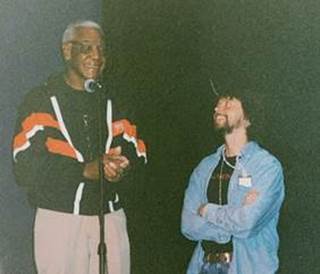
Baseball then moved to its TV home on PBS, airing the full series over nine nights from September 19 to September 28. The filmmakers had been worried that fans angry about the strike would not be interested in watching. Lynn Novick: “Why would somebody want to watch 18 hours of history of something they now hate? It was beautiful to see the exact opposite happened: The series filled a void.”
Or as stated by Ken Burns, “We were the only game in town.” Millions of TV watchers agreed. And Buck O’Neil became an overnight star at the age of 82. Ken Burns: “After the documentary was first broadcast in 1994, and Buck became known to a national audience, he told me he felt lucky to get the attention because he said, ‘I’ve been sayin’ these things for 60 years – and now people are listening.’ I told him we were the lucky ones, for having the chance to listen to him.”

After Buck did not receive the necessary votes for induction in 2006, Burns says that he, Bob Costas and Joe Morgan “made a big, big, big stink, and we didn’t stop yelling and screaming until we turned blue in the face.” Their reaction, as well as many others, caused the Hall of Fame to quickly try and soften the blow. In 2008, they dedicated a statue to Buck and established the Buck O’Neil Lifetime Achievement Award. Rita and I got a look when we were in Cooperstown in 2016.
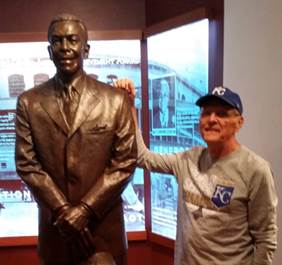
Buck became like family to Burns, including Buck treating Burns’ daughters as his own grandchildren. Burns told KC Star sportswriter Vahe Gregorian that Burns’ daughter Sarah detoured hundreds of miles out of the way while on her honeymoon to visit Buck in the hospital in his final days.
The same family connection was true for Lynn Novick (shown below with Buck). When her son was born, she named him James Jordan Novick-Smith so he would share the same middle name as John Jordan “Buck” O’Neil.
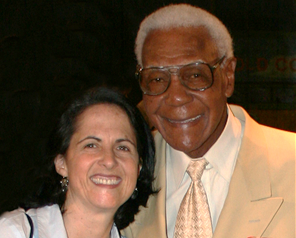
Burns was unable to attend Hall of Fame weekend because of conflicts related to his next PBS series (the Holocaust). Novick was in Cooperstown accompanied by her now-grown son James Jordan.
On the Saturday before induction Sunday, the Negro Leagues Baseball Museum and the Royals sponsored a “Thanks a Million Buck” brunch. Channel 41 was there and filmed cameos of Joe Posnanski, John Sherman, Bob Costas, Bob Kendrick, Lynn Novick, James Jordan Novick-Smith and Buck’s niece Dr. Angela Terry. Click here (4:00).
Thanks so much to Ken Burns and Lynn Novick. And of course Buck.
Buck O’Neil and Danny Cox: Now for a song about Buck. In May of 2021, Rita and I attended a production by the Lyric Opera. As most readers know, I’m more of a vintage rock ‘n’ roller than an opera type. But Hot Stove reader Crosby Kemper assured me I should see Baseball: A Musical Love Letter, which is more like a Broadway musical and features songs about baseball. I knew Crosby might be biased – his wife Deborah Sandler Kemper is the General Director and CEO of the Lyric.
Crosby was right. The production and performances were superb and captured many of the reasons we love baseball. After the main show concluded, Kansas City legend Danny Cox came on stage, and in his trademark booming voice, sang his composition “The Ballad of Buck O’Neil.” It brought down the house – an enthusiastic standing ovation.
In honor of Buck O’Neil’s Hall of Fame induction, the Lyric has posted Danny’s performance on YouTube (click here). Really good.

In early July, Crosby and Deborah were in Cooperstown. Crosby’s pilgrimage included some quality time with Buck.

Lonnie’s Jukebox – Buck O’Neil Edition: In his autobiography, Buck gave an indication of artists he enjoyed. He spoke of at least 50 night clubs in the 18th and Vine area, saying he had seen Charlie Parker, Duke Ellington, Jay McShann, Big Joe Turner, Dinah Washington and others. He loved staying at the Street Hotel at 18th and Paseo and coming down to the dining room and seeing the likes of Cab Calloway and Billie Holiday.
One of my favorite quotes from Buck reflects the different hours worked by baseball players and jazz musicians: “‘Good morning Count,’ I’d say. ‘Good evening, Buck,’ Mr. Basie would say.”
So I’ll start the Jukebox selections with Buck’s friend Count Basie…
“Did You See Jackie Robinson Hit That Ball” by Count Basie & His Orchestra. This piece was in the setlist in the baseball musical we saw at the Lyric Opera. When Basie’s version was released in 1949, Jackie Robinson was in his third season with the Dodgers and Buck O’Neil was the player-manager for the Monarchs.
“What a Difference a Day Makes” by Dinah Washington. This song was released about the time I graduated from high school in 1959. Buck likely heard her first in the 1940s, and I’m guessing he was still keeping up with Dinah in 1959 when he was scouting for the Cubs. In 1962, Buck became the first MLB Black coach. The Cubs gave Buck a shout-out at Wrigley field when he was inducted into the Hall of Fame.
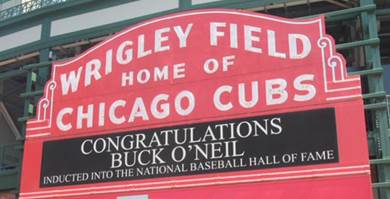
“Mood Indigo” by Duke Ellington. When I started college at Rolla in the fall of 1959, the album Ellington Indigos was often heard in my new home, the Sigma Nu fraternity house.
“A Train” by Jay McShann (piano), Mike White (sax), Tommy Ruskin (drums) and Milt Abel (bass). Mike has also been known to practice law and was my partner for many years (in law that is; I can’t carry a tune).
“Yardbird Suite” by Charlie Parker. I had expert help on this selection. Chuck Haddix, a/k/a Chuck Haddock, host of KCUR’s Fish Fry and author of Bird: The Life and Music of Charlie Parker.
“Shake, Rattle and Roll” by Big Joe Turner. This blues shouter got his start as a singing bartender in Kansas City. When Turner recorded this song at Atlantic Records in New York, the shouting chorus included Atlantic executives Ahmet Ertegun and Jerry Wexler. Turner, Ertegun and Wexler are all in the Rock and Roll Hall of Fame.
Turner took “Shake, Rattle and Roll” to #1 on the R&B charts in 1954. That was the year I started the 8th grade, and I was listening to radio stations that played the cover version by Bill Haley and his Comets. I bought and still have my Haley 45 rpm record. Years later, I heard local jazz/bluesman David Basse sing the song, and his version is definitely in the style of Big Joe Turner, not Bill Haley. I like David’s cover. So I bought a Joe Turner CD (pre-Spotify days).
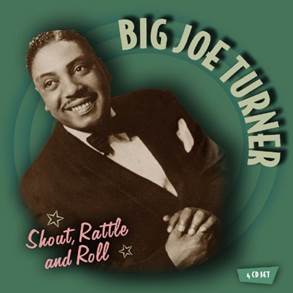
Hot Stove Managing Editor Rita insisted that Buck have the last word, so…
“Take Me Out To the Ball Game” by Buck O’Neil.